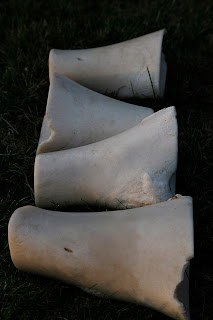I took advantage of a recent clear day to shoot this exercise, which is why it appears slightly out of order. This exercise hasn't, I expect, been very popular amongst students as it involves taking an entire day to carefully shoot the identical photograph of a scene for all the hours of daylight at least every hour and on a day of direct sunlight. Such days are not particularly common in winter but I was lucky enough to encounter a good forecast for a day I had free in Narita, near Tokyo. The scene was to be a landscape with a fairly definite subject that would catch the sunlight even when close to the horizon and that would receive the sunlight throughout the day. Sun rise at this location would be 6:03am and sun set 5:57pm.
I am not a devoted landscape photographer, unlike
Glyn Davies whose work I greatly admire (I am a frequent visitor to his
blog), so I am not used to getting up to be in place for first light. It was quite a shock to find myself setting up my tripod at 5:30am rushing to get my camera set up before I lost the pre-dawn light. Once the initial shots were taken I found the labours of either waiting in near zero temperatures with a biting wind for an hour to pass or trotting the mile into town for a quick warming coffee before rushing back to be in place for the next shot something of a trial.
The results are below and although there are undoubtedly many better landscape views available around the world, this one seemed to fit the bill and I was pleased with my results. The scene is part of the Narita-san Shinsho-ji Temple and although the views that met the brief were few I managed to get one that looked Nth Est (about 065 deg). This meant the sun would rise on my right, travel behind me during the day and set to my left. Being winter and therefore a low sun, that would ensure that I could view the effects of the light without having to worry about shooting into sun.
1/4sec f11 ISO400
5:40am
1/60 f11 ISO400
6:10am
1/250 f11 ISO800
6:30am
1/250 f11 ISO800
7:00am
1/200 f11 ISO200
8:00am
1/400 f11 ISO200
9:00am
1/500 f11 ISO200
10:00am
1/500 f11 ISO200
11:00am
1/800 f11 ISO200
12:00 noon
1/800 f11 ISO200
1:00pm
1/500 f11 ISO200
2:00pm
1/500 f11 ISO200
3:00pm
1/400 f14 ISO400
4:00pm
1/60 f11 ISO200
4:40pm
1/80 f8 ISO400
5:20pm
3sec f14 ISO800
5:50pm
20sec f11 ISO200
6:10pm
So, which of these images do I prefer? I arrived to recce the scene the previous day at about 3pm and at that time I thought the foreground stone wall and signpost would serve well, the middle ground of the smaller temple buildings would give some interesting shadows and trees with the tall pagoda in the background would catch the very last of the light. The disadvantage of having to keep the same shooting angle throughout the entire day meant that at times the view was quite plain. Even when the light was at its best it was very frustrating not to be able to swing around and adjust the focal length to get the best from the view. As it turned out, local effects put my foreground mainly into shadow during the golden hours but the signpost caught a lovely evening shaft of sunlight in the 4:40pm image. I expected dawn to be the best period as I was looking to the Nth Est and was going to catch the sunrise on the right edge. Unfortunately, needing a cloud free day meant that many of the eye catching effects that a low sun has when reflecting off cloud weren't available so it wasn't as good as I hoped. Again, I was hoping that the sunset would provide beautiful illumination of the trees and the pagoda, which it did, but I needed to tighten up my shot to take advantage of it. Surprisingly, my best shot came in the minutes after sunset as the last of the light picked out the cloud to the North whilst the street lights picked out the details of the trees and buildings below.
























































